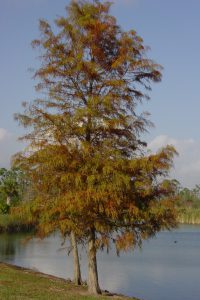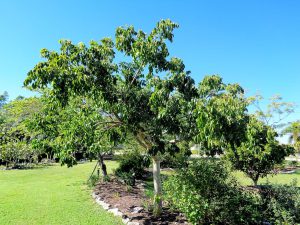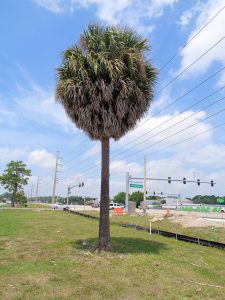While many tree failures can be traced to structural weaknesses that could be eliminated with training, some trees (and palms) are just naturally more wind resistant than others and better apt to survive a hurricane. Many other factors can all contribute to tree stability in high winds including the amount of rain, tree health, soil conditions, and even other surrounding trees. What are some of the trees and palms that have shown better survivability?
First, some lessons learned from past hurricanes. Hurricanes can produce irresistible forces that trees just cannot bear. There is a limit as to what a tree can take and not be damaged. However, there is safety in numbers. Trees that were planted in groups survived better than individual specimens. Groups of trees would be defined as five or more trees growing in a cluster, not a row. As a group, palms do better in hurricanes than do woody, broad-leaved trees and conifers. Sabal palms are particularly hurricane-resistant, as is the Canary Island date palm. On the other hand, Washington and Queen palms do not survive hurricanes well and regularly fail. Pine trees that appear to have survived unscathed after a hurricane may not show decline for months after the event. Hidden damage from twisting and bending may not show up as a fatal internal injury until later. Losing leaves in a hurricane does not mean a tree is dead. Most trees have sufficient resources to send out new leaves and recover. The loss of leaves actually helps some trees better survive high winds.

Studies suggest that native trees survive better than exotic trees in south Florida – think live oaks, gumbo limbo and Sabal palm for example. There are also some commonsense observations such as older trees are more likely to fail than younger trees. Unhealthy trees with pre-existing defects are also often predisposed to fail. Trees with included bark, poor structure and those subject to poor pruning programs are also more likely to be damaged.

So, what trees might you select for the best storm resistance? Keeping in mind “right plant for the right place” consider Live oaks, Sand Live oaks, Podocarpus, Gumbo Limbo, Magnolia, Dahoon holly, and Crape Myrtles. Bald Cypress are conifers that take high wind very well. For palms try Pindo palms, Date palms, Pygmy date palms, Arecas, and as mentioned previously Canary Island Date palms and Sabal palms. This is just a small list and there are other trees listed under high wind resistance and even medium to high resistance. There are also many trees which have medium to low and low wind resistance that may need to be avoided.

There is always the possibility that high winds interacting with trees may result in some damage. You can never be one-hundred percent sure with living things like trees, and there are many variables making some of these recommendations a moving target. However, with careful consideration and past observations as a base, coupled with best management practices, you can make good choices that will likely succeed. For more information on all types of trees suitable for our area, you can also call the Master Gardener Volunteer Helpdesk on Mondays, Wednesdays and Fridays from 1 to 4 pm at 764-4340 for gardening help and insight into their role as an Extension volunteer. Ralph E. Mitchell is the Director/Horticulture Agent for UF/IFAS Extension – Charlotte County. He can be reached at 941-764-4344 or ralph.mitchell@charlottecountyfl.gov. Connect with us on social media. Like us on Facebook @CharlotteCountyExtension and follow us on Instagram @ifascharco.
Resource:
Duryea, M. L. & Kampf, E. (2017) Winds and Trees: Lessons Learned from Hurricanes. The University of Florida Extension Service, IFAS.
Duryea, M. L. & Kampf, E. (2021) Selecting Tropical and Subtropical Tree Species for Wind Resistance. The University of Florida Extension Service, IFAS.
Source: UF/IFAS Pest Alert
Note: All images and contents are the property of UF/IFAS.



